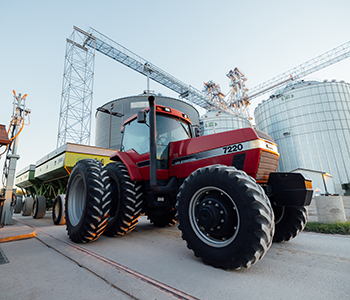Breaking Down Our Long-Term Grain Outlook
Sep 05, 2023

Zack Gardner, Grain Marketing & Origination Specialist
Colton Voga, Grain Merchandiser
WHAT IS OUR long-term grain outlook now that the August USDA report is out of the way? Overall, the report was friendly—not bullish, but at least not bearish. It was a good mix of production decreases alongside some demand destruction. In the end, both corn and soybean production were lowered more than demand.
Here’s a quick recap:
So, what’s our long-term outlook? We’re bearish toward corn and leaning friendly on soybeans. Here’s why:
Colton Voga, Grain Merchandiser
WHAT IS OUR long-term grain outlook now that the August USDA report is out of the way? Overall, the report was friendly—not bullish, but at least not bearish. It was a good mix of production decreases alongside some demand destruction. In the end, both corn and soybean production were lowered more than demand.
Here’s a quick recap:
- Corn yield came in with a 2.4 bu/acre drop, from 177.5 to 175.1 bu/acre. That was lower than the average of estimates. As for demand destruction, feed usage was lowered by 25 million bushels, and exports were lowered by 50 million bushels. Overall, our ending carryout of the crop we’re currently growing (or our surplus at the end of the year) dropped by 60 million bushels.
- Soybean yield was lowered by 1.1 bu/acre, from 52 to 50.9 bu/ acre. Similar to corn, we saw overall demand lowered to offset some of the drop in production. Imports were up 10 million bushels, and exports were lowered by 25 million bushels. The net change to our carryout was a decrease of 55 million bushels.
So, what’s our long-term outlook? We’re bearish toward corn and leaning friendly on soybeans. Here’s why:
- It seems like whatever we do, we can’t get below a 2 billion bushel carryout/surplus at the end of the year. If our recent rains bump us back up to a 177 bu/acre corn crop in the next USDA report, we will have a stocks-use ratio of 17.7 percent and an average cash price of $3.85. Several central Midwest states had production hiccups this year. Illinois is improving, but they are still far from great, which has significant impacts on our corn balance sheet. But demand destruction is just that big! Russia shut down the Black Sea a couple of months ago, and we have yet to see one export sale come our way from that event. Brazil produced a record corn crop this year that completely offset the Black Sea getting taken offline. We’re simply not the market for corn.
- Beans, on the other hand, might get a little exciting. We must be careful not to say “bullish,” because we don’t want to give any of you an excuse to not take advantage of really profitable bean prices if you see them. However, our new crop bean supply is looking very tight, with a pretty friendly outlook. Since the August report lowered our yield to 50.9 bu/acre, we’ve sold 51 percent of our new crop soybean carryout/surplus to China. Our carryout went down from 300 million bushels to 150 million bushels, which is what is considered rounding errors. On top of that, the soy crush data that was just released for July said we crushed 173.3 million bushels. That is 2 million bushels above estimates and 8.3 million bushels above the previous month. The U.S.’s soy crush is strong, which means we will start with the tank that much emptier going into harvest. This sounds pretty bullish.
- The really nice rains we saw a couple of weeks ago lead us to confidently say yields won’t go lower. Were they enough to bring soybean yields back up to 52 bu/acre? A lot of producers said they saw 10 bu/acre rains! Just a 1.1 bu/acre bump back up to 52 bu/acre would put us back into the 6 percent stocks-to-use area, with an average cash price of $11.50. We could easily out-yield this crazy demand.
- China is still the wild card. They’ve been stockpiling cheap Brazilian beans over the past couple months. They probably have enough that they won’t have to buy from us, even if we are the cheapest source this fall. In addition, they’re experiencing some deep economic issues right now. In mid-August, China’s third property development company failed to repay bonds, their central banking system cut interest rates while the rest of the world is raising them and the youth unemployment rate increased to a point where the Chinese Communist Party decided to stop recording and publishing the data. We don’t know the full story, but worsening economic issues don’t usually lead to more demand and more consumption.